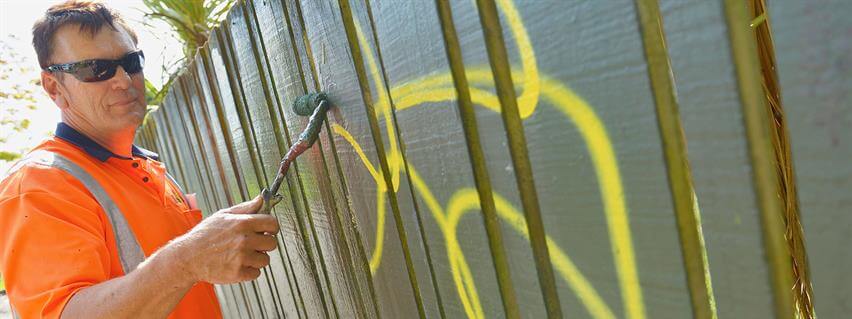
A council employee removing graffiti | Image via CC
I hope you all had a relaxing long weekend.
Did you know, the ‘geography of fear’ relates to how an individual’s perception of their personal safety varies across a given area. This can be influenced by a number of factors, not solely crime levels, but also familiarity and personal experiences within the area as well as environmental factors such as land use (commercial/residential), levels of lighting, isolation, visibility to others and levels of general repair or graffiti.
Graffiti is the factor I would like to again highlight today as it can make people feel less safe within their local environment. One tag may not seem a problem, but one becomes two becomes three and so on, as the presence of graffiti encourages more graffiti. The cumulative cost to remove graffiti and repair the surfaces involved can be substantial.
When I say graffiti, I am not meaning wall murals, commissioned, and created with permission. Graffiti is the ad-hoc drawing of a “tag” or slogan, be it with spray paint or some other medium, on any surface without permission. For the most part, graffiti appears on publicly accessible property or a private property adjacent. Motivation for tagging varies, from gang insignias and territory marking to political messaging to spontaneous acts of youth. One person can be responsible for a large amount of graffiti, either in a short space of time or over a prolonged period, linked through their use of a single identifying “tag”. It is unfair to say that this is purely a youth issue however, as is shown through the range of motivations above.
Cambridge has seen an increase in the incidence of graffiti in recent months. Being able to hold offenders to account depends both on our ability to catch them in the act and to receive confirmed information from our community. We need your help to find out who is involved with these activities and who is using a specific tag. CCTV footage is also a valuable resource in this regard.
Taggers usually adopt a specific tag identity and will frequently practice it, including drawing it on their personal belongings. If you have any information as to who is responsible for a specific tag, we would be very keen to know. Report to 105 or anonymously to crimestoppers on 0800 555111.
The continued presence of graffiti in a location, encourages more. Graffiti is wilful damage, and a specific charge applies. If graffiti appears on your property, please photograph it, report to 105 either by phone or online and remove or paint it out promptly. This ensures we can get an accurate picture of what and where graffiti is happening and identify trends and linkages. If you see people in the act of graffitiing, call 111 immediately.









